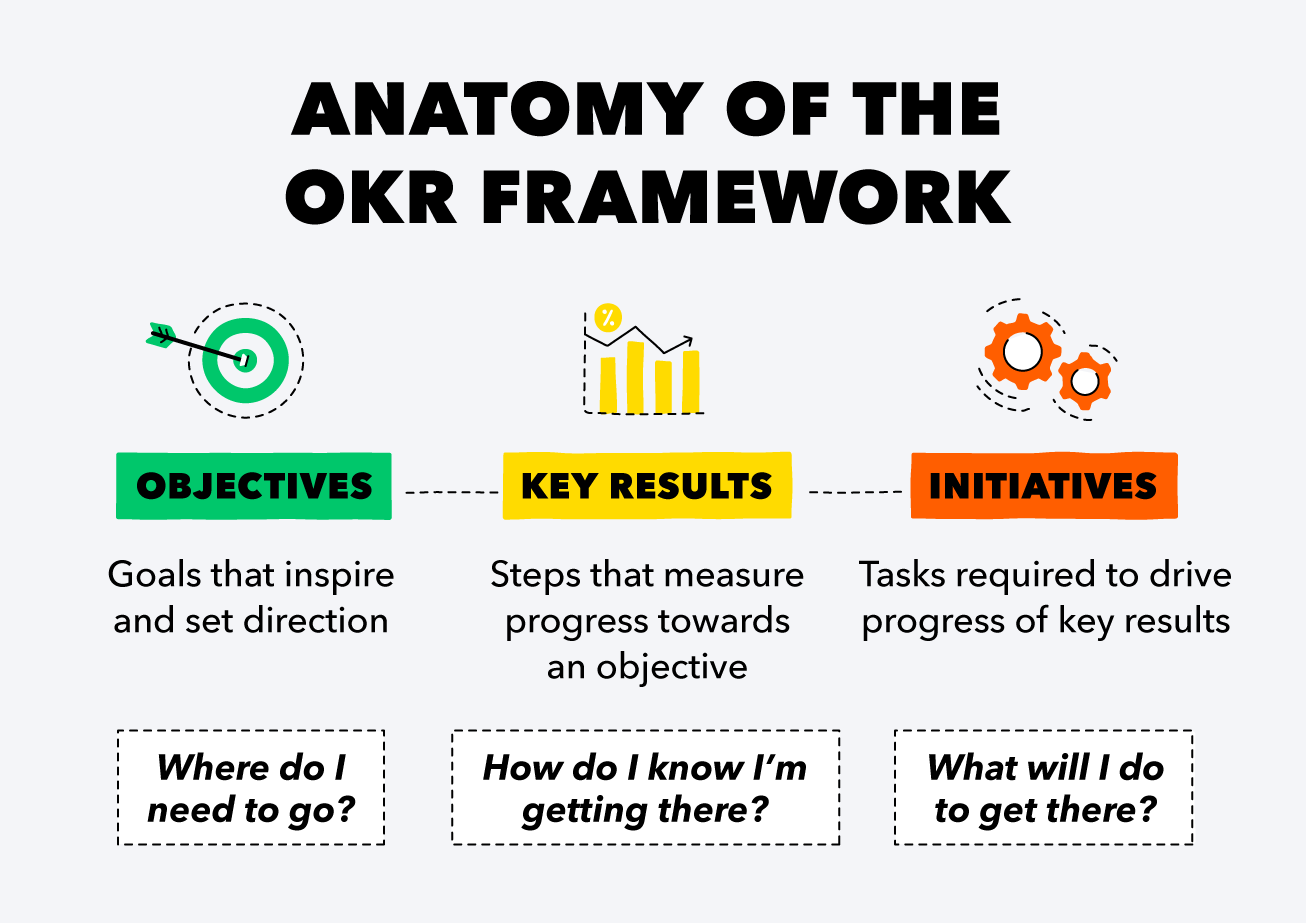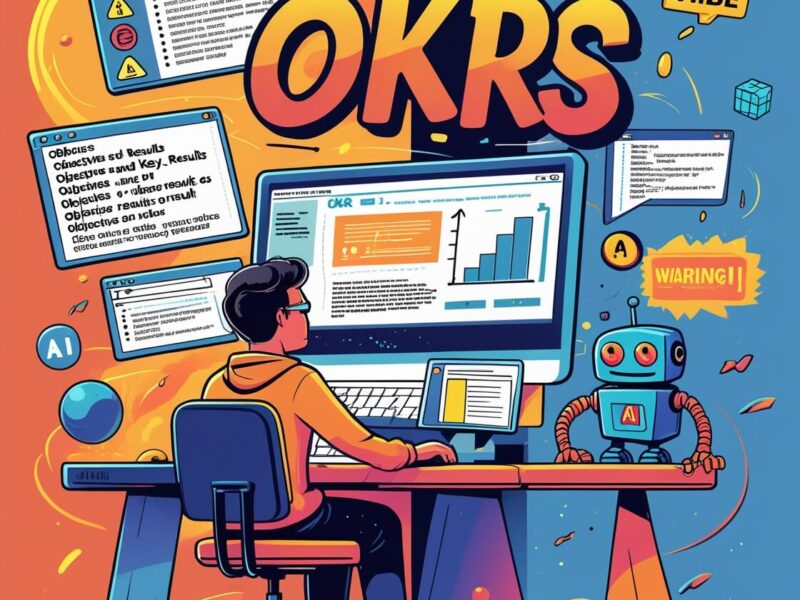OKRs, or “Objectives and Key Results,” are a widely used framework for setting, tracking, and achieving goals within organizations.
Originally developed at Intel in the 1970s and later popularized by John Doerr in Measure What Matters, OKRs have become a cornerstone of goal management for companies like Google, LinkedIn, and Twitter.
But what happens when we analyze OKRs through the lens of human-centered design (HCD)? Let’s dive into how this approach transforms OKRs into a tool that not only drives organizational success but also ensures meaningful, inclusive, and impactful progress.
What Are OKRs?
At their core, OKRs consist of two components:
- Objectives: Clear, specific, and inspiring goals that an individual, team, or organization aims to achieve.
- Key Results: Quantifiable metrics used to measure progress toward those objectives.
For example:
- Objective: Improve customer satisfaction.
- Key Results:
- Increase Net Promoter Score (NPS) from 70 to 85.
- Reduce average customer support response time from 24 hours to 12 hours.
- Achieve a 95% satisfaction rate in post-support surveys.
OKRs emphasize transparency, accountability, and alignment, making them highly adaptable across industries and team structures.
The Human-Centered Design Approach
Human-centered design (HCD) is a methodology that places the needs, goals, and experiences of people at the forefront of the design process. Whether designing a product, service, or system, HCD ensures that solutions are meaningful, accessible, and valuable to end users.
When applied to OKRs, HCD shifts the focus from top-down goal-setting to a more collaborative, inclusive process. It emphasizes:
- Empathy: Understanding the needs and aspirations of employees and stakeholders.
- Involvement: Engaging all members of the organization in the goal-setting process.
- Iteration: Continuously refining objectives and key results based on feedback and progress.
Why OKRs Align with Human-Centered Design Principles
1. Focusing on What Matters Most
HCD encourages prioritizing what truly matters to users—in this case, employees and stakeholders. OKRs provide a framework for identifying and addressing the most pressing challenges and opportunities within an organization. When crafted with empathy, OKRs ensure that:
- Objectives align with the personal and professional goals of employees.
- Key results reflect meaningful progress for all stakeholders.
2. Promoting Collaboration and Engagement
OKRs thrive in environments where transparency and collaboration are valued. A human-centered approach ensures that:
- Employees across all levels contribute to the goal-setting process.
- Teams feel a sense of ownership and alignment with organizational objectives.
- Cross-functional collaboration is encouraged to achieve shared goals.
3. Driving Continuous Improvement
Both OKRs and HCD emphasize iteration and adaptation. By regularly reviewing progress, organizations can:
- Identify barriers to success.
- Adjust objectives and key results as needed.
- Foster a culture of learning and innovation.
Defining OKRs from a Human-Centered Design Perspective
To define OKRs through an HCD lens, follow these steps:
Step 1: Involve All Members in Goal-Setting
Gather input from employees, stakeholders, and customers to ensure objectives reflect diverse perspectives and needs. Use methods like:
- Workshops and brainstorming sessions.
- Focus groups and stakeholder interviews.
- Surveys and user feedback tools.
Step 2: Identify Key Challenges and Opportunities
Conduct research to understand the organizational landscape. This includes:
- Analyzing customer data and market trends.
- Gathering feedback on internal processes.
- Highlighting pain points and areas for growth.
Step 3: Set SMART Objectives
Ensure objectives are Specific, Measurable, Achievable, Relevant, and Time-bound. For example:
- Specific: What exactly do you want to achieve?
- Measurable: How will success be quantified?
- Achievable: Is this goal realistic given current resources?
- Relevant: Does this align with organizational priorities?
- Time-bound: What is the timeframe for achieving this?
Step 4: Define Quantifiable Key Results
Key results should provide a clear picture of progress. For example:
- Replace vague statements (e.g., “Improve team performance”) with measurable outcomes (e.g., “Increase project completion rate from 85% to 95%”).
Step 5: Communicate and Align
Share OKRs across the organization to:
- Ensure everyone understands the objectives.
- Foster alignment and accountability.
- Encourage teams to connect their work to broader goals.
Step 6: Monitor and Iterate
Regularly review OKR progress through:
- Weekly check-ins or quarterly reviews.
- Data dashboards to track metrics.
- Open discussions about challenges and adjustments.
Common Mistakes in Human-Centered OKRs
Avoid these pitfalls to maximize the impact of your OKRs:
1. Excluding Key Stakeholders
When goals are set by a select few, they risk being irrelevant or misaligned with organizational needs. Inclusion ensures relevance and buy-in.
2. Setting Vague Objectives
Ambiguous goals like “Improve performance” lack direction. Instead, aim for clarity and specificity.
3. Neglecting Organizational Strategy
OKRs must support broader strategic goals. Misalignment leads to wasted effort and disjointed progress.
4. Overly Ambitious Key Results
Unrealistic metrics can demotivate employees. Strike a balance between challenging and achievable.
5. Failing to Iterate
Static OKRs become obsolete in dynamic environments. Regular reviews are essential for relevance and success.
Real-World Examples of OKRs with a Human-Centered Focus
Example 1: Enhancing Employee Well-Being
Objective: Foster a healthier work environment.
Key Results:
- Increase participation in wellness programs from 50% to 75%.
- Reduce average employee overtime hours by 20%.
- Achieve a 90% satisfaction rate in quarterly wellness surveys.
Example 2: Improving Customer Experience
Objective: Elevate customer satisfaction levels.
Key Results:
- Achieve a customer retention rate of 95%.
- Resolve 90% of support tickets within 24 hours.
- Increase NPS from 60 to 80 within six months.
Final Thoughts: OKRs as a Human-Centered Tool
When approached through a human-centered design perspective, OKRs become more than just a goal-setting framework—they transform into a mechanism for meaningful collaboration, innovation, and impact. By involving stakeholders, prioritizing empathy, and iterating based on feedback, organizations can ensure their goals not only drive success but also resonate with the people who make that success possible.
References and Further Reading:
- John Doerr’s Measure What Matters: https://www.whatmatters.com
- Google’s Approach to OKRs: https://rework.withgoogle.com
- Human-Centered Design Principles: https://www.ideou.com/pages/design-thinking
- SMART Goal Framework: https://www.mindtools.com
If you’re interested in continuous learning about OKR, you should visit “How to Use the OKR Framework to Reach Your Life Goals“


